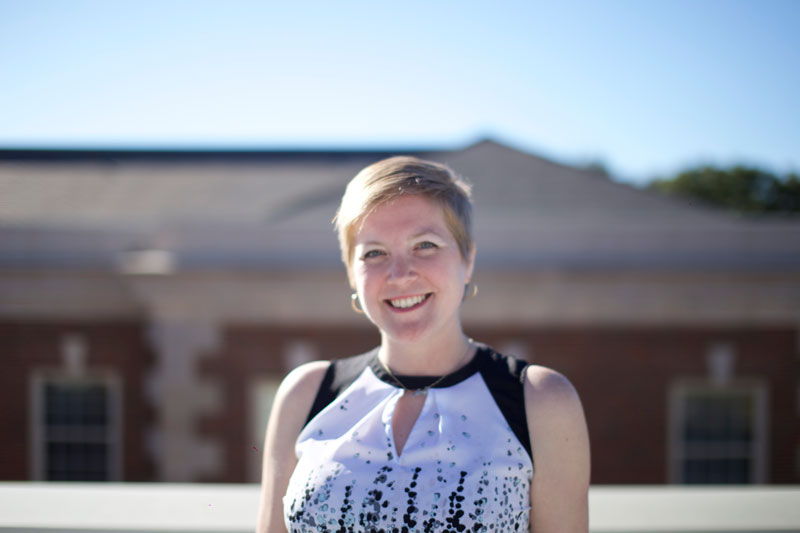
Amy Pirkle is a book artist and letterpress printer who runs her own small press, Perkolator Press. Her works can be found across the nation, with pieces in permanent collections at over 50 universities (Yale, Carnegie Mellon, and Duke, just to name a few). Despite Pirkle’s busy printing schedule, she still finds time to teach five classes at her alma mater, The University of Alabama. She teaches foundations art classes and book arts classes, and advises the New College Review, a literary magazine produced each year. Pirkle is the perfect example of an exceptional teacher at UA. Not only does she contribute great real world skills to the classroom, but she helps students develop their creative talents.
Amy Pirkle wasn’t always a book artist or a member of the Crimson Tide. In fact, it was a study abroad trip to Italy, while she was finishing her undergraduate degree at Mercer that brought her here. Pirkle, who had never heard of book arts before, stumbled into an elective in it.
“I had never heard of book arts,” Pirkle explains, “but taking that class in Cortona, Italy, changed my life. I had gone to Italy to study painting, but after I got back and finished my degree at Mercer, I only looked at schools with Book Arts MFA programs. I got into the book arts program here at UA in 2004, and I’ve been here ever since.” For those of you who have never heard of the term “book arts,” it is what it sounds like: the art of the book. Book artists approach the book as a medium to explore conceptual ideas, in the same way that painters may approach a canvas or photographers use their cameras. The field of book arts encompasses hand bookbinding, papermaking, printmaking, letterpress printing, photography, sculpture, and more. It is truly an interdisciplinary medium.
During Pirkle’s third year as an MFA student at UA, she wanted to gain experience teaching at the college level as a Teaching Assistant. However, there were no introductory courses in book arts that she could instruct on her own. After much searching, Pirkle was introduced to UA’s New College, which allows students to design their own depth studies around an interdisciplinary major. The New College director then, James Hall, let Pirkle design a NEW 490 special topics class in Book Arts, which she began teaching in the spring of 2007.
Once she was a member of the New College family, Amy became the advisor for the New College Review magazine. Pirkle was no stranger to the editing world; she had worked on the award-winning literary magazine The Dulcimer as an undergraduate student at Mercer. “Since I had the experience of book arts and had worked on the literary magazine, The Dulcimer, while I was a student, it kind of just fit and made sense that I help with the New College Review,” Pirkle says. She has served as the faculty advisor for the NCR for the past eight years.
Next spring, the NCR staff will release the newest edition of the New College Review on Honors Day. The theme for 2016 issue is Escape- how do people escape, where do they escape to, and why do we feel the need to escape? She states, “Most of the articles and pieces that appear are from members of the magazine staff. We take outside submissions as well; we just make sure they fit the theme.” When asked if there were any specific submissions that stand out from last year’s Masquerade-themed magazine, she replied, “Randy Arnold was not a member of the staff last year, but his piece was published. It was very well researched and interesting, a bit more formal than some of the other pieces.”
Pirkle explains that editing a literary magazine is beneficial to the students involved. Staff members will learn concepts like “working together with a team for long hours and getting things in on time.” She finds importance in “the idea of conceptualizing a project and seeing it through to the end.”
Although the 2015 issue of New College Review is already published, Pirkle’s year is anything but over. She is currently working on binding her most recent project, The Twin Code. Binding, she explains, can be the most time-consuming part of her process. Pirkle works in editions, producing multiple copies of each book she creates (at least 15 identical copies of a book, but as many as 50 or 60 copies). Because each book is bound by hand (cutting pages, folding, sewing, gluing, etc.), it often takes several hours to complete just one book. When the book structure is particularly complex, it may take up to ten hours to bind just one copy. Multiply that by the number of books in the edition, and you start to see why it takes so much time to finish an edition. Once she finishes binding, she will move on to a new project. She does not reveal her next topic, but offers these clues: “Memory and time are the two main things that inspire me. Specifically, I’m interested in how memory changes over time.”
Pirkle says she really enjoys living in Tuscaloosa. She has seen the community grow, both physically and culturally, and notes that, since her arrival, “there have been many improvements, especially in the art community here.” Her husband also works for the University, so she does see herself continuing to teach at Alabama. “I really do love all the classes that I teach,” Pirkle admits. “I’m lucky, because I like them all.” Pirkle, who teaches five classes, tries to encourage most students to attempt a class in the arts. “Just challenge yourself to try something new, to grow. While you’re here, taste a little bit of everything. You never know what you are going to find. Look at me: I had never heard of book arts before, and now it’s my life!”